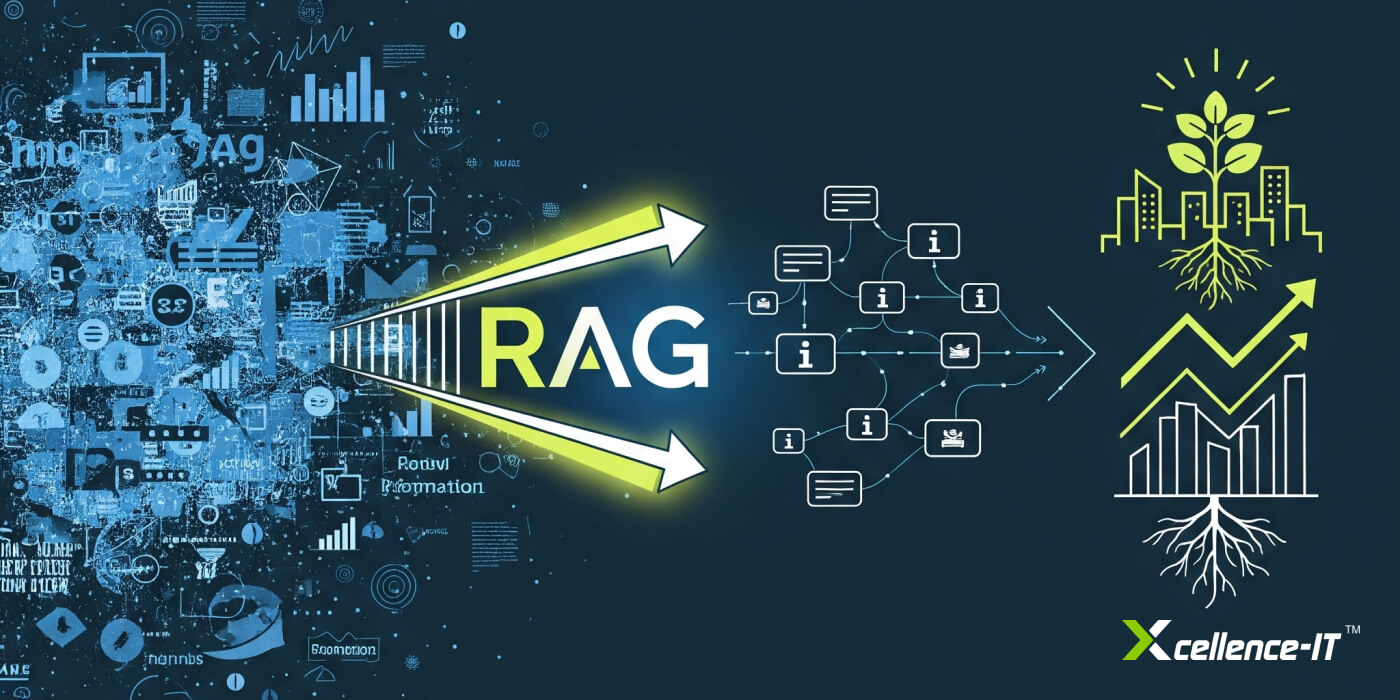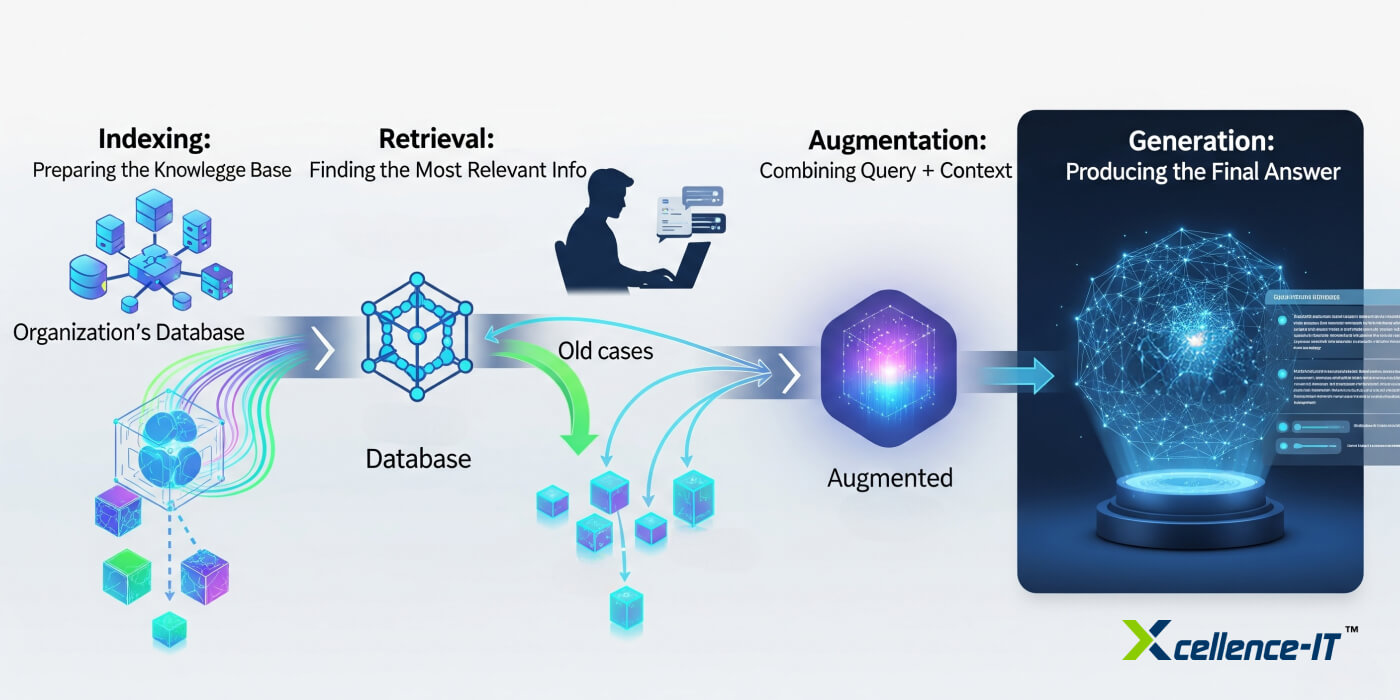
Data has become the world’s most valuable asset, but with billions of pieces of information generated daily, turning raw data into clear, reliable insights is a huge challenge for businesses today.
Retrieval-Augmented Generation (RAG) is rapidly emerging as a revolutionary AI technology that bridges this gap. By combining real-time information retrieval with advanced language models, RAG empowers organizations to unlock smarter decisions, streamline workflows, and innovate faster than ever before.
This blog dives deep into what RAG is, why it’s a critical tool for modern enterprises, and how it’s reshaping industries worldwide.
What is Retrieval-Augmented Generation (RAG)?
RAG combines two powerful AI techniques: retrieval and generation. Unlike traditional AI models that rely solely on pre-trained knowledge and sometimes “hallucinate” information, RAG dynamically retrieves relevant, up-to-date data from external sources and integrates it into its answers.
Imagine having an AI assistant that not only “knows” a lot but can also check the latest data, research papers, or legal documents before responding. This combination ensures accuracy, freshness, and context-awareness, making RAG a breakthrough for business applications.
How RAG Works: A Step-by-Step Breakdown
1. Indexing: Preparing the Knowledge Base
Before answering any queries, RAG needs access to a searchable database. This could be a company’s internal docs, scientific journals, or a public dataset. Each document is broken down into chunks and converted into embeddings, mathematical representations of meaning. These are stored in a vector database for fast similarity matching.
2. Retrieval: Finding the Most Relevant Info
When a user asks a question, that question is also turned into an embedding. The system searches the vector database for the most semantically similar chunks, like a librarian finding the most relevant pages in a giant book collection.
3. Augmentation: Combining Query + Context
The top results from the retrieval step are combined with the user’s original question. This “augmented prompt” gives the LLM both the query and the relevant background it needs to respond accurately.
4. Generation: Producing the Final Answer
Finally, the LLM takes the augmented prompt and generates a response. Because it has access to recent and relevant information, the result is far more accurate, grounded, and trustworthy, often with the ability to cite sources.

How RAG Solves Critical Business Challenges
Many organizations face critical challenges that slow growth and weaken their competitive edge. Retrieval-Augmented Generation (RAG) directly tackles these issues, turning obstacles into opportunities for smarter, faster decisions.
- Outdated or Incomplete Information: Decisions based on stale data can lead to costly errors. RAG continuously updates its knowledge base to deliver current insights.
- Information Overload: Employees spend a lot of time hunting through complicated document systems. RAG instantly surfaces precise, relevant answers.
- AI Hallucinations: Conventional AI can invent facts, risking trust and compliance. RAG grounds responses in verified documents, reducing inaccuracies.
- Siloed Data: Business knowledge scattered across systems becomes inaccessible. RAG unifies data sources into a single accessible knowledge network.
- Compliance Risks: In regulated industries, accuracy is paramount. RAG provides traceable, sourced information to satisfy auditors and regulators.
- High Retraining Costs: AI models need expensive and slow retraining to stay current. RAG refreshes knowledge instantly without reprogramming.
By addressing these challenges, RAG accelerates innovation, reduces operational risk, and boosts employee productivity.
Applications of Retrieval-Augmented Generation (RAG) Across Industries
Finance: Fraud detection and risk management benefit from real-time access to up-to-date regulations and transactional data.
Example: Companies like Morgan Stanley leverage advanced AI tools that combine data retrieval and real-time insights to help advisors make informed decisions quickly and detect unusual transaction patterns to minimize fraud risks.
Healthcare: Clinicians use RAG-informed systems to consult the latest studies and patient records, supporting accurate diagnoses.
Example: Leading hospitals such as Mayo Clinic use AI-driven platforms that access current clinical guidelines alongside patient data, enabling doctors to provide personalized treatment. Telehealth services similarly integrate real-time knowledge retrieval to offer up-to-date advice during virtual consultations.
Legal: Law firms retrieve relevant precedents and statutes rapidly to prepare cases and ensure compliance.
Example: Firms like Baker McKenzie employ AI-powered research assistants that fetch relevant case law and regulatory updates quickly, helping reduce research time and improve accuracy.
Retail and E-commerce: AI-powered personalized recommendations and dynamic search improve customer experience and sales.
Example: E-commerce giants like Amazon use AI systems that combine real-time inventory data with user behavior to deliver personalized product suggestions. Zalando employs similar AI-driven search enhancements, helping customers find products quickly even with vague queries.
Manufacturing: RAG streamlines maintenance operations by surfacing technical manuals and incident records on demand.
Example: Companies like Siemens utilize AI tools that give technicians instant access to machine maintenance logs and manuals, speeding up repairs and improving operational efficiency.
Customer Support: Chatbots leveraging RAG answer complex customer queries accurately, reducing wait times and boosting satisfaction.
Example: Delivery platforms such as DoorDash use AI chatbots that pull live tracking data and order updates to provide customers with precise and timely information.
These examples demonstrate how RAG transforms AI from static information providers into dynamic, intelligent business partners. By integrating real-time data retrieval with advanced AI, RAG powers smarter decision-making and enhances operational efficiency, making it a key component of modern industrial automation solutions.
Who Should Adopt RAG and Why
Retrieval-Augmented Generation (RAG) is a powerful solution for any business or organization managing complex data and needing fast, trustworthy insights. It’s especially useful for those that:
- Operate in regulated industries or fast-changing markets where up-to-date information is crucial.
- Face challenges accessing knowledge spread across multiple systems or departments.
- Require AI that delivers consistent, fact-based answers instead of guesses.
- Aim to improve customer experiences with intelligent, responsive, and personalized interactions.
- Need scalable AI solutions that avoid expensive, frequent retraining cycles.
Why RAG Is Rapidly Gaining Ground in Enterprise AI
Retrieval-Augmented Generation (RAG) is quickly becoming essential for enterprise AI. According to a Deloitte report, over 70% of enterprises now use RAG to improve large language models (LLMs), making AI outputs more accurate and reliable.
The return on investment is impressive. Businesses using RAG systems like GraphRAG report up to 3x ROI, thanks to faster insights, better customer engagement, and efficient access to internal data. More broadly, AI investments average $3.50 in value for every $1 spent.
RAG also tackles a major productivity drain: according to a report employees spend about 1.8 hours daily searching for information. With RAG’s semantic search, relevant answers appear instantly, saving valuable time.
Accuracy is another critical factor. AI models can hallucinate up to 48% of the time, leading to errors. RAG reduces hallucinations by grounding responses in trusted data, sometimes by as much as 70%.
Lastly, poor data quality costs businesses an average of $12.9 million yearly, and 70% of leaders doubt their forecasting data. RAG ensures access to fresh, reliable info, improving decisions and outcomes.
Addressing Common Concerns and Misconceptions About RAG
Adopting new AI technology often raises questions and concerns. Here’s some clarity to ease your mind and help guide your decision:
Is RAG Complex or Costly to Implement?
While RAG involves sophisticated AI, many platforms offer modular, scalable solutions tailored to your needs. You don’t have to overhaul everything at once, start small with a pilot project and expand gradually. This approach helps control costs and reduces complexity.
Does RAG Replace Human Workers?
No, RAG is designed to empower your team, not replace them. By automating routine information retrieval and providing accurate answers, it frees employees to focus on higher-value tasks like problem-solving and relationship-building. It’s a powerful assistant that boosts productivity and job satisfaction.
How Does RAG Handle Data Privacy and Security?
Security is a top priority. RAG solutions typically include features like data encryption, strict access controls, and audit trails to protect your information. Before implementation, work closely with IT and compliance teams to ensure your RAG platform meets industry standards and regulations, especially in sensitive sectors like finance and healthcare.
Benefits of RAG for Business Growth in 2025
The importance of RAG in modern business cannot be overstated:
- Accuracy & Trust: Fact-based AI responses build confidence among users and regulators.
- Cost Efficiency: Avoid costly retraining by updating knowledge bases instead of AI models.
- Flexibility: Customize and adapt RAG solutions to unique business domains without disrupting workflows.
- Innovation Acceleration: Quick access to relevant knowledge empowers faster product development and smarter strategy.
- Employee Empowerment: Enable teams to retrieve comprehensive context in seconds, boosting productivity.
- Competitive Edge: Deliver superior customer and market insights that drive smarter decisions.
RAG is not just an AI upgrade, it is a strategic business capability essential for the connected, data-driven economy.
Final Insights
Retrieval-Augmented Generation represents a paradigm shift in AI, moving from standalone language models to intelligent systems connected to real-world knowledge. For business leaders aiming to harness AI’s full power, RAG offers a compelling path to increased accuracy, agility, and trust, critical ingredients in today’s competitive markets.
Is your business ready for the AI revolution that RAG promises? Connect with us to explore AI solutions designed to enhance your data insights and drive smarter decisions.

Leave a reply